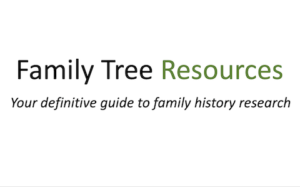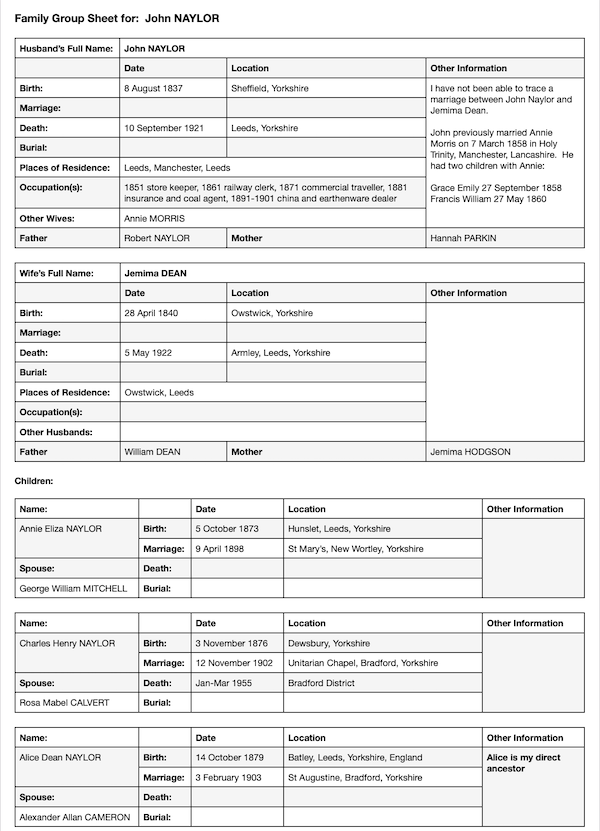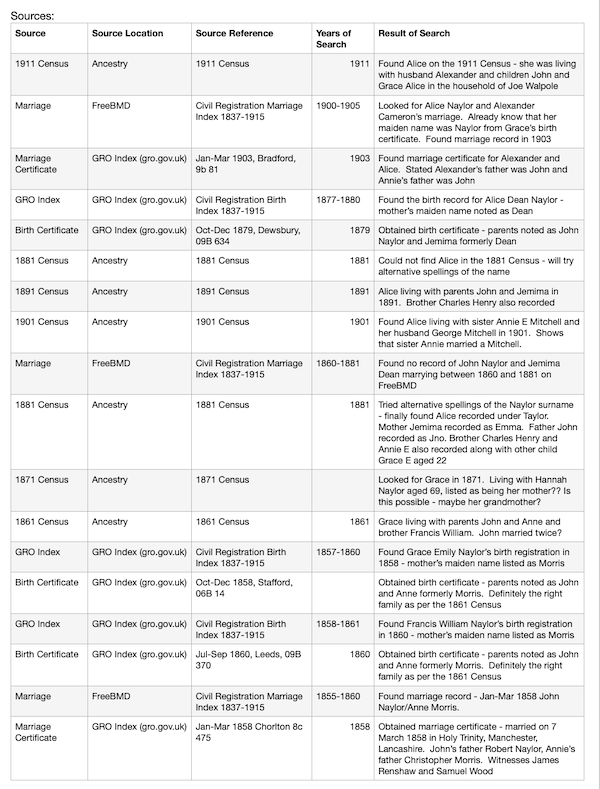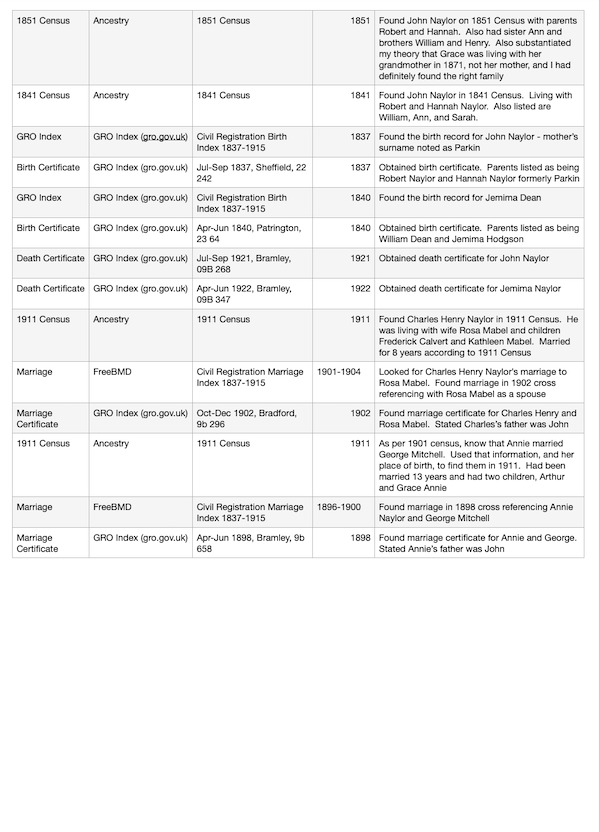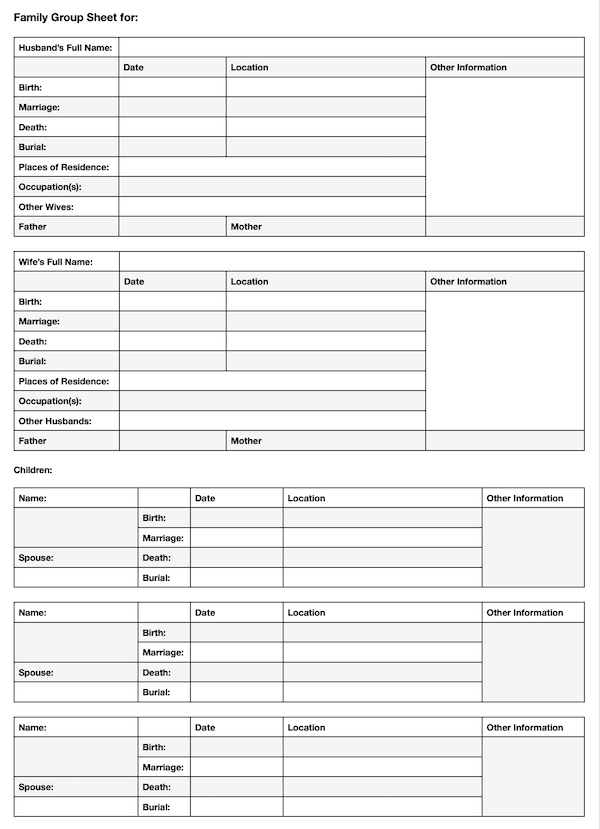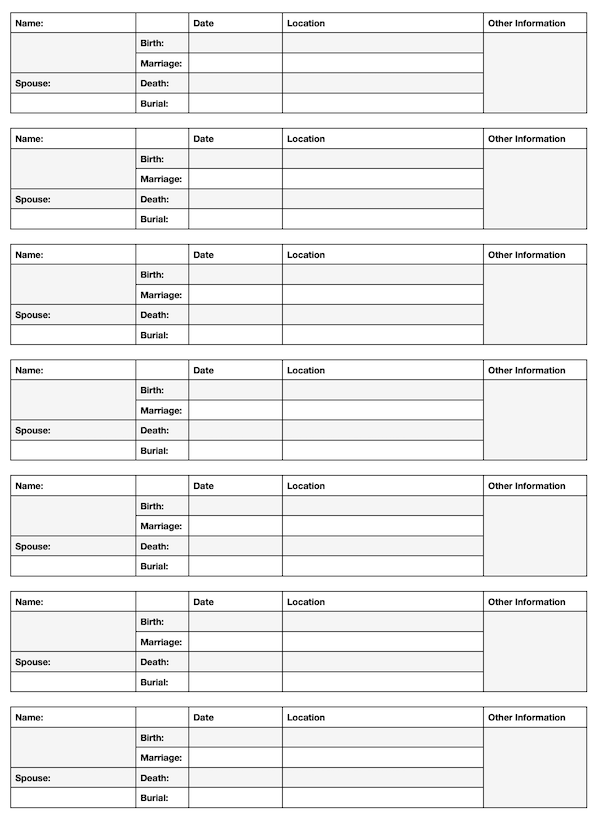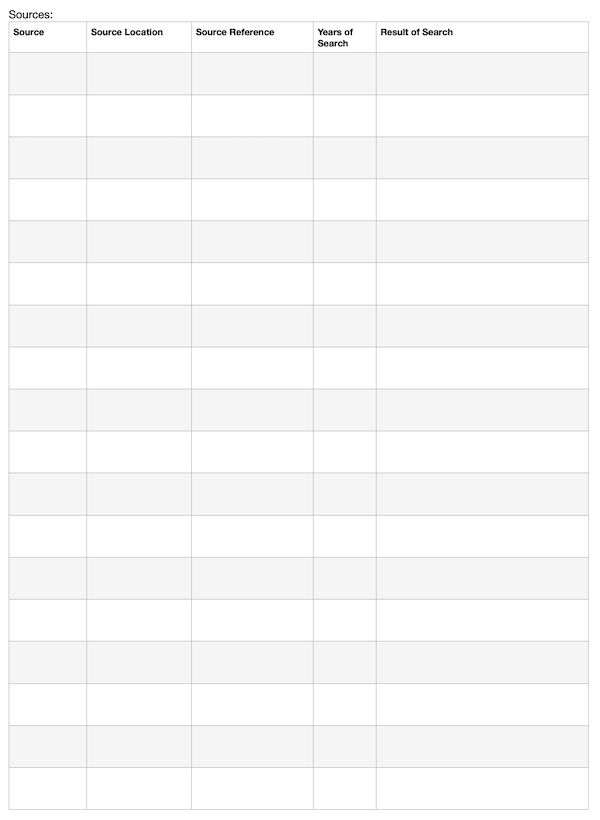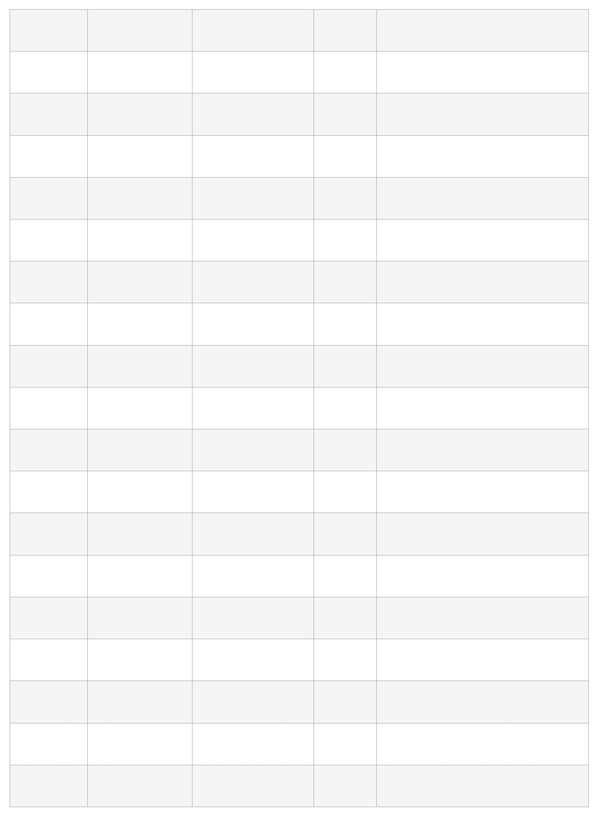Once you start your family history research, you will need to find some way of recording the information you have collected. One of the most popular ways of displaying this information is to use a family group sheet.
What A Family Group Sheet Is
A family group sheet is used to record details of parents and their children. Many family group sheets have space to record details of their birth, marriage and death dates and locations. It can also be used to record details of the father’s occupation(s) and any previous wives.
For the mother, there is room to include details of any previous husbands, and her occupation if she had one.
Additional information regarding the family can also be recorded on a family group sheet, such as the children from any previous marriage your relative may have had.
A family group sheet also includes details of any children born to the parents, including their birth, marriage and death dates and locations. There is also room to note the child’s spouse.
Not only can you record the children born to the couple, you can also record details of the couple’s parents, thus you can record three generations of the family on one sheet. A family group sheet also has room to include the sources of the information you have discovered.
How To Fill in a Family Group Sheet
When filling in your family group sheet, it is always best to start with the parents, recording their full name, date and place of birth, date and place of marriage and date and place of death. When you are recording your ancestor’s surname, it is best to record this in all capitals to help distinguish the surname from your ancestor’s other names, especially if your ancestor has a surname that could be confused with a first name such as Cameron. If you write Cameron as CAMERON, it is easy to distinguish this as a surname.
Whatever format you choose when writing the date, you should use this method all the way through your sheet. It is also best to write the date writing the month as Jan or January for example.
Writing the date in this format will help avoid confusion if you are showing your tree to other people, especially if you are showing the sheet to people in another country. If you write the date as 11/1/1800, this could be taken to mean 11 January 1800 or November 1, 1800.
You can also record the date and place of burial if you discover when and where they were buried. You can then move on to record the parents of the husband and wife.
It is best to record the children born to the couple in the order in which they were born. You should always start with the oldest child first, including any information you know about the child, such as name, date and place of birth, date and place of marriage, and date and place of death. You can also record the spouse’s name where applicable.
When you are recording the children, you should write down all the names they were given. This will help to distinguish between two children of similar names, especially if one child died and another child was given the same name.
Once you have filled in the information regarding the parents and children, you should also include the source of the information you have uncovered. This is very important because it can save you from wondering where you found the information and can help you to prove your research if showing the tree to other people.
Noting the source is also important because you can then easily go back to the source should you need to. If, for example, you have perused a marriage record, you may find that the names of the witnesses have suddenly become more important the more you research your family tree.
It could be that a sister, for example, has got married and she and her husband are the witnesses to a brother’s or sister’s marriage. This information has not only helped you to distinguish the correct bride or groom, it has also helped you to find out more details about the sister’s family.
I have included an example of how I have filled in a family group sheet for my ancestor John Naylor. Please click on the image to view an enlarged version in PDF format.
Where To Find Family Group Sheets
If you are using family tree software to record your family history research, you will probably find that the software populates a family group sheet for you. The one drawback to using a family group sheet included with computer software, however, is that you cannot alter its appearance and change it to include details you wish to know at a glance. If, for example, you wish to include your ancestor’s occupation, it may not include this on the sheet.
How To Edit a Family Group Sheet
I have included a blank chart, which you are free to download if you wish. It is available in PDF format, so it can be edited using an iPad if you have one, or it can also be edited using Xodo on Windows or an Android tablet. Please click on the image(s) to bring up the PDF sheet(s)
If you wish, you can download the chart to the cloud, DropBox, Google Drive, or Apple iCloud or any other file sharing utility so you can easily add more information if you are conducting research in a record office or library.
If you and other family members are all working on the tree together, you can give them all access and editing rights so that they can add information as they find it.
It is also possible to simply print the chart off and fill it in by hand. You can easily print off the chart and take it with you to a record office or library, and fill it in by hand in the record office and transfer the information to an electronic version once you are home.
Organising Your Family Group Sheets
If you print off your family group sheets to file them away in a binder, it is a good idea to place the family group sheet in the front of the papers for your ancestor, and then place any other papers such as printouts or transcripts from parish registers, copies of census returns etc, behind the group sheet.
You can therefore keep all papers connected to your ancestor in one place so that you can easily find all the appropriate paperwork without having to search through many papers.
It may be prudent to give your ancestor the same number on this chart that you have used throughout your family history so that you can easily cross reference between documents such as ahnentafel charts and pedigree charts. To find out more information about how to complete these charts, and how they can help your family history research, please view my articles on these topics.
If you wish to keep electronic versions of your family group sheets, you can always create a folder for each ancestor, perhaps even labelling it with your ancestor’s number as well, and transferring the sheet into your folder. In this way, you can keep all your information for each ancestor together, so you can easily see if you are missing any source or information such as a census return or entry in a parish register. Pedigree Charts and Ahnentafel Charts can also be kept in this folder.
Advantages of a Family Group Sheet
One of the main advantages of this chart is that you are able to see at a glance up to three generations on one sheet of paper.
Another advantage of this method of recording your research is that you can easily see where you need to conduct more investigations, such as finding a date of death or a location of a vital event.
If you are conducting an interview with a family member about the family tree, and wish to record details of the family, you can easily use a family group sheet to begin noting down what they remember about their parents and grandparents.
It may be prudent in this case, even though it is recommended to start with the parents, to start with the child and write down what they remember about their parent’s dates and places of birth, marriage and death. You then have some information to use when you start looking at official sources such as census returns.
You can also easily make a note of the sources you have consulted using the family group sheet. This will make it easier to find the source again should you need to. I knew, from looking at the census returns I had consulted, that I had yet to find John Naylor in the 1881 Census. I knew that I had to look at this source again to see if I had missed anything.
Using just the first names of the family, rather than name and surname, I found out that they were indeed listed on the 1881 Census. I discovered that they were not only listed as Taylor in the census index, but in the actual census, and that they lived in Taylor Street!
I think that is where the confusion with the names originated. No wonder I had trouble tracking them down!! If I had not made a note of which census returns I had found the family in, I would have felt the need to go through each census again, which would have been very time consuming.
Another advantage of using a family group sheet is that it can help you to distinguish between two families of the same name. If you find, for example, that there is more than one John and Mary Robinson, seeing the names of the children on the family group sheet will help you to distinguish one from the other on the census and therefore you will research the correct family.
If you have hit a brick wall in your family history research, and cannot find any information about your direct ancestor, such as a date of death, noting all the children on the family group sheet may help you to track them down. I could not find the date of death of my great-grandfather William George Baker, but I knew that my grandmother had many siblings.
Whilst I was looking in the electoral register for William Thomas Baker, my grandmother’s brother, I saw that William George Baker was living with him and his family. Seeing when he was no longer in the electoral register gave me some idea as to when he died, and I subsequently found the death record and ordered the death certificate.
Sure enough, it was the right William George Baker, and I had finally found him. The sad part of this tale is that my Dad never knew his grandfather even though he was 16 when he died in 1953. For more information about electoral registers and how to use them for family history research, please visit my page about electoral registers.
If you are showing the family group sheet to an elderly relative, and they are on it, the information contained on the chart may help them to remember information about the family. It may help them to remember that they had a relative who died young, or when their grandparents died.
This is all information that could help you to fill in any blanks you may have in your sheet. One of my big regrets is that I did not ask my grandparents more questions about the family whilst they were still alive. Now any information they may have had is lost forever.
Drawbacks of a Family Group Sheet
One of the main drawbacks of the chart is that there is not much room to include more detail about the family if you find a lot of information about them. If you find, for instance, that the father served in the military, there is not really enough room in the chart to record that much information.
Another drawback of the chart is that if you find the parents had several children, it could take several sheets of paper to record them all. My own ancestors had 11 children, so it would be very difficult to record information about them all on one single sheet of paper. It would more than likely take up more than even two sheets of paper.
Having a family group sheet could, therefore, take up a lot of space in your collection. It may be prudent, under these circumstances, to keep the chart in electronic format, especially if space is at a premium.
If you also wish to include the source of all the information you have uncovered, this would also obviously require many sheets of paper, depending on how much information you have found and how many sources you have perused.
Now you can enter the information about your ancestors into your own family group sheets – enjoy the journey and most importantly, have fun. You can also use family group sheets in conjunction with pedigree charts and ahnentafel charts. Good luck with your own research journeys.
